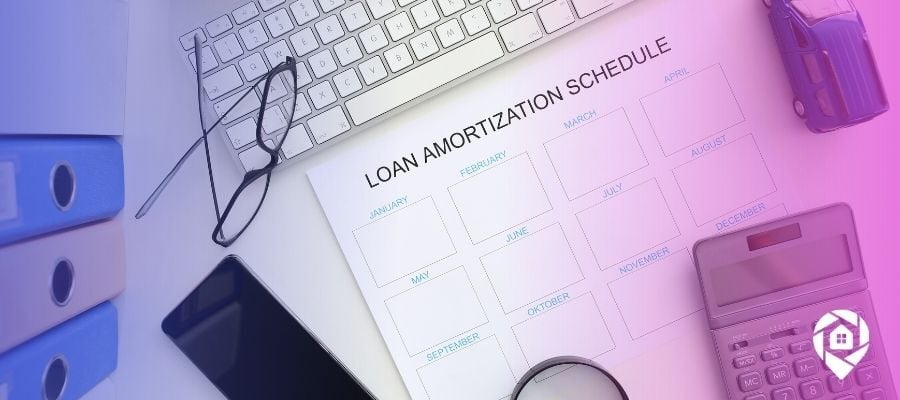
The Basics of Amortization in Real Estate Explained

In real estate investing, understanding key financial tools can give you a real advantage. One of the most important tools to learn is amortization. It’s the process that shows how your loan is paid off over time through regular payments.
When you understand real estate amortization, you can better manage your finances, make smarter investment choices, and build long-term success. Even finding your first deal becomes easier when you know how amortization affects your cash flow and equity.
Understanding Amortization
Amortization is a method used to pay off a loan through regular, scheduled payments. Each payment covers both the loan’s principal, the amount borrowed, and the interest charged by the lender.
In real estate, this process is important because it provides a clear path to paying down debt over time. As the loan progresses, a larger portion of each payment goes toward the principal, while the interest portion gradually decreases.
Understanding real estate amortization helps investors plan ahead, track equity growth, and stay financially prepared. Many successful investors credit this knowledge as a key part of building long-term value in their portfolios.
How Amortization Works
To go deeper into the mechanics of amortization, there are two main components of a loan payment: the principal and the interest.
- Principal: This is the original amount of money borrowed from the lender. Each payment made reduces the principal balance.
- Interest: This is the cost of borrowing money, usually expressed as an annual percentage rate (APR). Interest is calculated on the remaining principal balance.
An amortization schedule is a detailed table that outlines each periodic payment on an amortized loan. It breaks down how much of each payment goes towards the principal and how much towards interest. As the loan progresses, the portion of the payment applied to the principal increases, while the interest portion decreases.
Consider a simple example of an amortization schedule for a 30-year fixed-rate mortgage of $300,000 at an interest rate of 4%:
- Month 1: Principal: $448.33, Interest: $1,000
- Month 2: Principal: $450.00, Interest: $998.33
- Month 3: Principal: $451.67, Interest: $996.66
The Importance of Amortization in Real Estate
Understanding how amortization works gives real estate investors several important advantages:
- It improves financial planning. Amortization helps create a clear picture of what your monthly payments will look like over time. This predictability makes it easier to set long-term budgets, especially when managing multiple properties or planning for future investments.
- It supports cost management. Knowing how each payment is split between principal and interest helps investors stay on top of expenses. It also makes it easier to prepare for additional costs like maintenance, property taxes, and insurance, especially when evaluating whether to hire a property manager.
- It helps build equity. As you pay down the principal, your ownership stake in the property increases. This growing equity can be used to finance future deals, improve cash flow, or serve as a financial cushion, an approach many experienced investors use to scale their portfolios.
Understanding these benefits makes amortization not just a loan detail, but a powerful part of your long-term real estate strategy.
Types of Amortization
Amortization can look different depending on the type of loan. Here are the main types that real estate investors might come across:
- Fully amortizing loans are the most common. With this structure, each monthly payment covers both interest and principal. By the end of the loan term, the entire balance is paid off. Traditional 15- or 30-year fixed-rate mortgages fall into this category.
- Partially amortizing loans involve regular payments that don’t completely pay off the loan by the end of the term. When the loan ends, a large final payment, called a balloon payment, is due. This structure is common in some commercial real estate deals and requires careful planning.
- Negative amortization happens when the payments made are too small to cover the interest owed. The unpaid interest gets added to the loan balance, causing the amount owed to increase over time. This can be risky and should be approached with caution, especially by new investors.
Each type of amortization affects your cash flow and risk differently. Knowing the structure of your loan helps you make informed decisions and avoid financial surprises down the road.
Amortization in Different Real Estate Scenarios
Amortization plays a role in almost every type of real estate investment. Here’s how it works across different property types:
- In residential real estate, such as single-family homes and condos, amortization makes monthly payments predictable. This consistency helps homeowners and small investors manage their budgets and plan for future upgrades or opportunities. It's also a useful tool when combining strategies like BRRRR (Buy, Rehab, Rent, Refinance, Repeat).
- In commercial real estate, amortization affects how deals are structured. Investors may deal with partially amortizing loans that include balloon payments. Knowing the repayment schedule is key to preparing for refinancing or selling the property before the final payment comes due.
- For investment properties, amortization can be used strategically to grow long-term wealth. By selecting the right loan terms, investors can manage cash flow, build equity faster, and use that equity to fund new opportunities. This approach supports a scalable and sustainable investment portfolio.
Each scenario requires a different strategy, but understanding amortization gives you the tools to make smarter financial decisions, no matter what type of property you're working with.
Tools and Resources
Having the right tools makes it easier to understand and manage amortization in real estate. Here are some helpful options:
- Online calculators can quickly show you how your payments break down over time. Just enter the loan amount, interest rate, and term to see your full amortization schedule. These tools are great for running quick comparisons between different loan options.
- Software programs offer more advanced features. Some can track multiple loans, generate reports, and help analyze how changes in interest rates or loan terms affect your investment. These tools are especially useful for investors managing several properties.
- Educational resources, like real estate courses, blogs, and video tutorials, can help you build a deeper understanding of amortization and how it fits into your overall strategy. Many successful investors continue learning through these platforms to stay sharp and up to date.
Using these resources and talking with a loan officer can help you make informed decisions and stay in control of your financial planning as your portfolio grows.
If you're still struggling to find funding for your deals, check out the video below for some helpful tips.
Conclusion
Understanding amortization is a key part of real estate investing. It helps you manage debt, build equity, and make smarter financial decisions over time. Whether you’re analyzing your first deal or growing your portfolio, knowing how amortization works gives you a real advantage.

About Samantha Ankney
Samantha is the Social Media Manager at DealMachine, where she oversees all social media strategies and content creation. With 4 years of experience at the company, she originally joined as a Media Specialist, leveraging her skills to enhance DealMachine's digital presence. Passionate about connecting with the community and driving engagement, Samantha is dedicated to sharing valuable insights and updates across all platforms.



